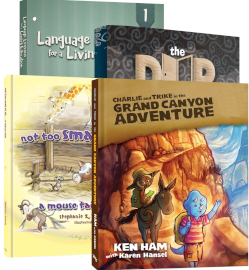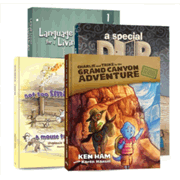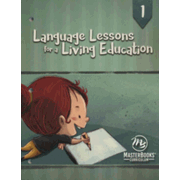Language Lessons for a Living Education 1 differs significantly from the other courses in this series. (See my reviews of level 2, levels 3 through 6, and levels 7 through 10.) This first-grade course is best used for one semester after the completion of Foundations Phonics (from the same publisher) or another phonics course. A one-semester schedule and an alternate two-semester schedule are both provided near the front of the book.
The 352-page coursebook, available in print or as a PDF, is heavily illustrated and features full color throughout. Three storybooks (also published by Master Books) are required for this course: Not Too Small at All: A Mouse Tale, Charlie and Trike in the Grand Canyon Adventure, and The Door of Salvation. (These are included in the curriculum pack sold by the publisher.)
One of the most important features of this course is that instruction for all aspects of language arts is in one resource, although it is supplemented with the three required books (as reading material) plus books of your choosing for reading practice.
Assuming a basic knowledge of phonics, this course teaches advanced phonograms, beginning with sp, tw, wh, mb, ck, ng, and nk, and concluding with squ, thr, dge, and tch. Students learn to read and write words and sentences, and they are introduced to beginning grammar—nouns, verbs, adjectives, punctuation, and capitalization—plus handwriting, and spelling. Handwriting (printing) is learned through direct instruction and copywork.
The lessons are scripted so that parents can simply read the instructional information and ask the questions provided within the lessons.
Teacher Aids at the back of the 352-page course book make up about one-third of the entire book. The Teacher Aids include answer keys, suggested reading lists, an assessment chart for tracking progress, and many pages for students, some required and some used at the discretion of the teacher. Among them are a list of sight words, phonics charts, lists of phonics and spelling rules, sentence rules, spelling words, forms for writing spelling words, pages for creating their own dictionary, directions for games, handwriting practice sheets, and copywork sheets.
How It Works
I’ll describe lesson plans according to the schedule for the one-semester course.
Mondays every other week are for reading from the three supplemental books. On the alternate Mondays, lessons present a poem, a scripture passage, or a picture to be studied. The supplemental books begin with Not Too Small at All, a story about the unique purposes for which God has created every creature. Charlie and Trike in the Grand Canyon Adventure, a creation-science adventure, is read next. None of the three supplemental books have controlled vocabulary, so parents begin by reading aloud to children, then gradually have students read words and sentences as they are able. By the time children near the end of the course, they might be able to read much of The Door of Salvation, a poetic presentation of the gospel message, on their own. Readings and picture studies are followed by questions for students to answer aloud. Some of the questions are open-ended, such as “What do you like about this painting?” while others ask for specific information. In addition, children are prompted for oral narrations—retelling what has just been read in their own words, and they practice recognizing sight words. Lastly, children are to begin reading aloud every day from books, such as those recommended in the Teacher Aids.
Tuesday is for reviewing and learning phonograms, and for learning to write. There are three to five workbook-style pages for students to complete. (If it’s too much for one day, save some for other days that require less time.)
On Wednesday, children review and apply phonetic concepts they’ve learned and discuss a picture, usually from the supplemental book being read. Spelling isn’t included until the fifth week, but after that, students work on spelling on Wednesdays and Thursdays each week.
Thursday’s lesson provides review, application, and practice exercises for reading, spelling, and grammar.
On Friday, children apply multiple language-arts skills as they create their own dictionary using preformatted Create Your Own Dictionary pages from the Teacher Aids.
Just for Fun activities and puzzles pop up on various days for children to practice critical thinking, problem-solving, or handwriting.
Throughout the course, parents can choose how much reading to require and can help children as needed, making Language Lessons 1 more flexible than some other first-grade programs.
Lessons should take 20 to 30 minutes a day, five days per week.
There are no tests, but the assessment charts in the Teacher Aids should be used to track student progress. Assessment charts show key objectives taught each week followed by two columns headed “Skill Mastered” and “Needs Experience.”
Optional video instruction is available through Master Books Academy.
Summary
Language Lessons for a Living Education 1 is easy for inexperienced homeschoolers to teach, and parents can control the pacing and amount of reading to suit each child.











